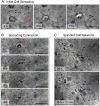Defining the role of matrix compliance and proteolysis in three-dimensional cell spreading and remodeling
- PMID: 18178662
- PMCID: PMC2267114
- DOI: 10.1529/biophysj.107.105841
Defining the role of matrix compliance and proteolysis in three-dimensional cell spreading and remodeling
Abstract
Recent studies have identified extracellular matrix (ECM) compliance as an influential factor in determining the fate of anchorage-dependent cells. We explore a method of examining the influence of ECM compliance on cell morphology and remodeling in three-dimensional culture. For this purpose, a biological ECM analog material was developed to pseudo-independently alter its biochemical and physical properties. A set of 18 material variants were prepared with shear modulus ranging from 10 to 700 Pa. Smooth muscle cells were encapsulated in these materials and time-lapse video microscopy was used to show a relationship between matrix modulus, proteolytic biodegradation, cell spreading, and cell compaction of the matrix. The proteolytic susceptibility of the matrix, the degree of matrix compaction, and the cell morphology were quantified for each of the material variants to correlate with the modulus data. The initial cell spreading into the hydrogel matrix was dependent on the proteolytic susceptibility of the materials, whereas the extent of cell compaction proved to be more correlated to the modulus of the material. Inhibition of matrix metalloproteinases profoundly affected initial cell spreading and remodeling even in the most compliant materials. We concluded that smooth muscle cells use proteolysis to form lamellipodia and tractional forces to contract and remodel their surrounding microenvironment. Matrix modulus can therefore be used to control the extent of cellular remodeling and compaction. This study further shows that the interconnection between matrix modulus and proteolytic resistance in the ECM may be partly uncoupled to provide insight into how cells interpret their physical three-dimensional microenvironment.
Figures








Similar articles
-
Mechanical, biochemical, and extracellular matrix effects on vascular smooth muscle cell phenotype.J Appl Physiol (1985). 2005 Jun;98(6):2321-7. doi: 10.1152/japplphysiol.01114.2004. J Appl Physiol (1985). 2005. PMID: 15894540 Review.
-
Time-dependent cellular morphogenesis and matrix stiffening in proteolytically responsive hydrogels.Acta Biomater. 2013 Aug;9(8):7630-9. doi: 10.1016/j.actbio.2013.04.030. Epub 2013 Apr 25. Acta Biomater. 2013. PMID: 23624218
-
Uncoupled investigation of scaffold modulus and mesh size on smooth muscle cell behavior.J Biomed Mater Res A. 2009 Jul;90(1):303-16. doi: 10.1002/jbm.a.32492. J Biomed Mater Res A. 2009. PMID: 19402139
-
The use of poly(ethylene glycol) hydrogels to investigate the impact of ECM chemistry and mechanics on smooth muscle cells.Biomaterials. 2006 Oct;27(28):4881-93. doi: 10.1016/j.biomaterials.2006.05.012. Epub 2006 Jun 9. Biomaterials. 2006. PMID: 16762407
-
Physical determinants of cell organization in soft media.Med Eng Phys. 2005 Nov;27(9):763-72. doi: 10.1016/j.medengphy.2005.04.007. Med Eng Phys. 2005. PMID: 15951217 Review.
Cited by
-
Marker profile for the evaluation of human umbilical artery smooth muscle cell quality obtained by different isolation and culture methods.Cytotechnology. 2016 Aug;68(4):701-11. doi: 10.1007/s10616-014-9822-0. Epub 2014 Dec 23. Cytotechnology. 2016. PMID: 25535117 Free PMC article.
-
Development of a three-dimensional bone-like construct in a soft self-assembling peptide matrix.Tissue Eng Part A. 2013 Apr;19(7-8):870-81. doi: 10.1089/ten.TEA.2012.0077. Epub 2013 Feb 14. Tissue Eng Part A. 2013. PMID: 23157379 Free PMC article.
-
Self-assembling multidomain peptide hydrogels: designed susceptibility to enzymatic cleavage allows enhanced cell migration and spreading.J Am Chem Soc. 2010 Mar 10;132(9):3217-23. doi: 10.1021/ja910481t. J Am Chem Soc. 2010. PMID: 20158218 Free PMC article.
-
Biomanufacturing Recombinantly Expressed Cripto-1 Protein in Anchorage-Dependent Mammalian Cells Growing in Suspension Bioreactors within a Three-Dimensional Hydrogel Microcarrier.Gels. 2023 Mar 18;9(3):243. doi: 10.3390/gels9030243. Gels. 2023. PMID: 36975692 Free PMC article.
-
Injectable laminin-functionalized hydrogel for nucleus pulposus regeneration.Biomaterials. 2013 Oct;34(30):7381-8. doi: 10.1016/j.biomaterials.2013.06.038. Epub 2013 Jul 10. Biomaterials. 2013. PMID: 23849345 Free PMC article.
References
-
- Pedersen, J. A., and M. A. Swartz. 2005. Mechanobiology in the third dimension. Ann. Biomed. Eng. 33:1469–1490. - PubMed
-
- Reddi, A. H. 1998. Role of morphogenetic proteins in skeletal tissue engineering and regeneration. Nat. Biotechnol. 16:247–252. - PubMed
-
- Bershadsky, A. D., N. Q. Balaban, and B. Geiger. 2003. Adhesion-dependent cell mechanosensitivity. Annu. Rev. Cell Dev. Biol. 19:677–695. - PubMed
-
- Drury, J. L., and D. J. Mooney. 2003. Hydrogels for tissue engineering: scaffold design variables and applications. Biomaterials. 24:4337–4351. - PubMed
Publication types
MeSH terms
Substances
LinkOut - more resources
Full Text Sources
Other Literature Sources

